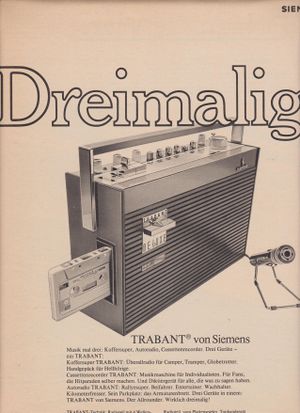Siemens Kofferradio Trabant de Luxe/en: Unterschied zwischen den Versionen
(Die Seite wurde neu angelegt: „=== Siemens TRABANT DE LUXE – car cassette recorder and portable radio in one ===“) |
(Die Seite wurde neu angelegt: „== Notes ==“) |
||
| (4 dazwischenliegende Versionen desselben Benutzers werden nicht angezeigt) | |||
| Zeile 7: | Zeile 7: | ||
=== Siemens TRABANT DE LUXE – car cassette recorder and portable radio in one === | === Siemens TRABANT DE LUXE – car cassette recorder and portable radio in one === | ||
At the end of the 1960s, Siemens launched an “all-rounder” radio as it was advertised: The TRABANT DE LUXE. The radio could receive long wave, medium wave, short wave and VHF. It had a cassette player and also came with a microphone. The Trabant didn’t need an external power supply, but was battery operated and could also be connected to a car battery. An additional power pack was available for purchase to allow it to be connected to the power grid. | |||
In terms of its shape and handle, the Trabant was a typical portable radio, a transistor radio that could be taken on trips thanks to its low weight and compact size. Advertising slogans claimed: “Überallradio für Camper.” (The mobile radio companion for campers), “Musikmaschine für Individualisten.” (The musicmaker for free spirits), “Beifahrer. Entertainer. Wachhalter” (Companion. Entertainer. Reviver.) | |||
A mounting bracket was provided to secure the Siemens Trabant in the car, since car radios were often not yet permanently built in at that time. The staff magazine inform carried a story in 1992 about ADAC recommending removable car radios to avert the threat of theft.<ref>BSH Corporate Archives, A05-0015, inform 1/1992, S. 15, „Autoknackern wird es oft zu leicht gemacht“.</ref> Car drivers in the 1950s even brought portable record players with them to play singles. However, it wasn’t long before the cassette replaced the record in the car, after all it was simply more practical. | |||
Combination devices that can be used in different places, such as the Siemens Trabant, are popular at the time because they eliminate the need to buy multiple radio/music devices. "Hand luggage for the clairaudient.", "Dictaphone for everyone who has something to say.", "Its parking space: the dashboard."<ref>Roland Söker: Auto mobil. Eine kleine Kulturgeschichte des Autoradios. Manuskript zur Radiosendung vom 26.12.2016, http://www.deutschlandfunk.de/geschichten-vom-radio-5-7-audio-mobil.2840.de.html?dram:article_id=371642 (viewed 9.5.2018).</ref> | |||
< | <span id="Einzelnachweise"></span> | ||
== | == Notes == | ||
Aktuelle Version vom 1. August 2023, 14:37 Uhr
“Music times three: portable radio, car radio, cassette recorder. Literally three-in-one!”[1]
Siemens TRABANT DE LUXE – car cassette recorder and portable radio in one
At the end of the 1960s, Siemens launched an “all-rounder” radio as it was advertised: The TRABANT DE LUXE. The radio could receive long wave, medium wave, short wave and VHF. It had a cassette player and also came with a microphone. The Trabant didn’t need an external power supply, but was battery operated and could also be connected to a car battery. An additional power pack was available for purchase to allow it to be connected to the power grid.
In terms of its shape and handle, the Trabant was a typical portable radio, a transistor radio that could be taken on trips thanks to its low weight and compact size. Advertising slogans claimed: “Überallradio für Camper.” (The mobile radio companion for campers), “Musikmaschine für Individualisten.” (The musicmaker for free spirits), “Beifahrer. Entertainer. Wachhalter” (Companion. Entertainer. Reviver.)
A mounting bracket was provided to secure the Siemens Trabant in the car, since car radios were often not yet permanently built in at that time. The staff magazine inform carried a story in 1992 about ADAC recommending removable car radios to avert the threat of theft.[2] Car drivers in the 1950s even brought portable record players with them to play singles. However, it wasn’t long before the cassette replaced the record in the car, after all it was simply more practical.
Combination devices that can be used in different places, such as the Siemens Trabant, are popular at the time because they eliminate the need to buy multiple radio/music devices. "Hand luggage for the clairaudient.", "Dictaphone for everyone who has something to say.", "Its parking space: the dashboard."[3]
Notes
- ↑ All Quotes: BSH Corporate Archives, C02-0126-002 und 003, promotional material for the Siemens Trabant De Luxe.
- ↑ BSH Corporate Archives, A05-0015, inform 1/1992, S. 15, „Autoknackern wird es oft zu leicht gemacht“.
- ↑ Roland Söker: Auto mobil. Eine kleine Kulturgeschichte des Autoradios. Manuskript zur Radiosendung vom 26.12.2016, http://www.deutschlandfunk.de/geschichten-vom-radio-5-7-audio-mobil.2840.de.html?dram:article_id=371642 (viewed 9.5.2018).
